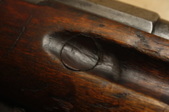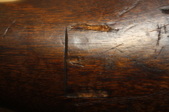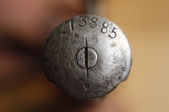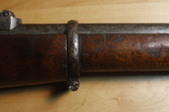
1
The entire rifle, including the Austrian produced M91 socket bayonet and scabbard.
| 
2
Markings on the barrel shank, indicating this rifle was made at the Tula arsenal in 1896. Note the lack of Finnish markings or defacing of the Imperial Russian markings.
| 
3
Closeup of the original M91 flat leaf rear sight. Note the slight bend to the sight. This is not original and is most likely the result of damage at some point in the rifle's nearly 120 year life.
| 
4
An unknown marking on the left side of the receiver. This doesn't appear to be Russian in origin and was probably added by the nation that captured this rifle.
Markings read "22801 A"
|

5
Closeup of the butt plate. Note the possible unit markings near the screw.
Markings read: "ALB.B.I"
The "I" is most likely a Roman numeral "1".
| 
6
Another closeup of the markings on the butt plate. Notice the original serial number has been crossed out, though it cannot be said if this was a Russian or Austrian modification as the new number doesn't match any other part of the rifle.
| 
7
Remains of the cartouche on the right hand side of the rifle stock. At this point it is impossible to decipher the marking, so it is unknown if this cartouche was for an 1896 Tula produced rifle.
| 
8
Closeup of the wooden cross bolt. This, along with a stock lacking any cross bolt, is very uncommon. Most of these stocks were upgraded with metal cross bolts typically found on M91 rifles.
|

9
Front sling hanger. This is not likely a Russian modification, as this type of hanger is often found on Austrian marked M91 rifle stocks.
| 
10
The rear sling swivel. Again, this is not likely Russian in origin. The swivel itself simply screws into the stock.
| 
11
An "E" carved into the left side of the stock right near the hand grip. This is possibly "trench art", but it certainly cannot be said when this was carved into the stock.
| 
12
Extreme closeup of the barrel shank markings. Note the detail of the Imperial Eagle.
|

13
The Tula hammer marking on the top of the rear sight, showing the sight is most likely original to the rifle and not a replacement.
| 
14
Serial number on the bolt. It does not match the rifle's serial number, but does match the number on the back of the cocking knob.
| 
15
The serial number on the cocking knob, matching the bolt body. Note the early style cocking knob.
| 
16
Closeup of the front sight and forward barrel band. The front barrel band is a later style production.
Also note the lack of a cleaning rod.
|

17
The rear barrel band.
| 
18
A closeup of the underside of the rear sight.
| 
19
Another shot of the rear sight.
| 
20
The Austrian produced M91 bayonet. Note the straight slot. This is a feature only found on these Austrian produced bayonets and helps differentiate it from the standard Russian M91 bayonet, which has to be slightly twisted to attach it to the rifle.
|

21
Closeup of the Austrian proof mark on the side of the bayonet. This is another sign of an Austrian produced M91 bayonet.
Markings read: "EA IX"
| 
22
The Austrian bayonet and the scabbard. The bayonet itself is still covered in a grease-like substance coating the inside of the scabbard.
Also note the green paint covering the scabbard.
| 
23
A closeup of the grease still covering the bayonet. It would seem likely that this was added when the bayonet was put into storage, but it cannot be said for sure.
| 
24
Closeup of the Austrian scabbard. Russia never produced scabbard for their Mosin Nagant bayonets though other countries, including Austria and Finland, did manufacture some small numbers of them.
|
